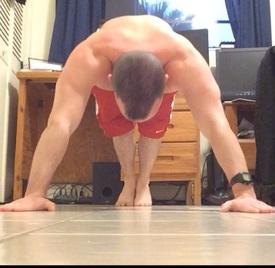Overhead Press, What is a full rep?!

FrnkLft
Posts: 1,821 Member
I learned the overhead press as barbell from chest/clavicles, up to full lockout, and back again.
Trainer on Monday (he's no bro, a serious guy), and another guy yesterday who has a previously torn shoulder both told me that it's best to rep from about eye level to lock out and back.
They say it's to protect your shoulders. I get it, but it just looks like a half-rep to me, and that's not something I'm into doing.
Anyone else "bottom out" at eye level and can explain why they do them?
Trainer on Monday (he's no bro, a serious guy), and another guy yesterday who has a previously torn shoulder both told me that it's best to rep from about eye level to lock out and back.
They say it's to protect your shoulders. I get it, but it just looks like a half-rep to me, and that's not something I'm into doing.
Anyone else "bottom out" at eye level and can explain why they do them?
0
Replies
-
Trainer on Monday (he's no bro, a serious guy), and another guy yesterday who has a previously torn shoulder both told me that it's best to rep from about eye level to lock out and back.
They say it's to protect your shoulders. I get it, but it just looks like a half-rep to me, and that's not something I'm into doing.
This is one reason I sort of prefer the dumbbell for OHP. I had a serious rotator cuff injury a couple of years ago (From a sports activity outside of the gym) and the barbell puts you in an unnatural position with that full range of motion. Most people can probably do it if you're healthy but it does put more stress on that joint if you take it all the way down. Even with the dumbbells I don't take the weight all the way down to my shoulders.0 -
Depends on grip width. Slightly outside shoulders, the bar should go about halfway from chin to collarbone. With a wide grip, I'll only take it to chin for shoulder safety.0
-
bump... I'm about to add these and I don't want to add an injury as well.0
-
Don't ever let anyone tell you that you need FULL RANGE OF MOTION. Everyone's range of motion is different. You will tear your rotator cuffs if you let the weights go too low. I personally just stop at the point where my arms are making a 90 degree bend then I push back up but I also don't lock out cause I personally think its not good for the joints, I like to keep tension on the muscles and locking out pretty much removes all tension from the muscles. That's just me tho, do what works best for you man.0
-
It helps to keep your shoulder packed all the way in the socket at lockout, with lats fired the whole time. If you disengage your lats and extend your shoulders all the way up, you are begging for an injury. Keeping it packed will protect your shoulder girdle.
I press from clavicle to lockout.0 -
Meh, I go from the chest.0
-
It helps to keep your shoulder packed all the way in the socket at lockout, with lats fired the whole time. If you disengage your lats and extend your shoulders all the way up, you are begging for an injury. Keeping it packed will protect your shoulder girdle.
I press from clavicle to lockout.
^ This is also what I do.0 -
My first guess would be it depends on your strength and flexibility? If I felt bringing it lower was beginning to strain my joints I'd stop but I'm unusually flexible and it's not like I have any power or strength yet. Someone let me know if I'm wrong.0
-
I go until my upper arm goes just past parallel with the floor, anything more tends to upset my elbows.0
-
I never bring my elbow down below shoulder level. It's less stressful on the joint.0
-
It helps to keep your shoulder packed all the way in the socket at lockout, with lats fired the whole time. If you disengage your lats and extend your shoulders all the way up, you are begging for an injury. Keeping it packed will protect your shoulder girdle.
I press from clavicle to lockout.
Rippetoe teaches the exact opposite. You want to shrug your shoulders up at the top of the movement to avoid shoulder impingement/excessive stress on the rotator.0 -
If there's nothing preventing you from doing a full range of motion then you should do it. I know you're doing 5/3/1 and I'm pretty sure Wendler talks form in his book. I actually have issues with my right shoulder from baseball and an old injury and OHP'ing with a full range of motion does nothing to cause any problems, I actually feel better to be honest.0
-
It helps to keep your shoulder packed all the way in the socket at lockout, with lats fired the whole time. If you disengage your lats and extend your shoulders all the way up, you are begging for an injury. Keeping it packed will protect your shoulder girdle.
I press from clavicle to lockout.
Rippetoe teaches the exact opposite. You want to shrug your shoulders up at the top of the movement to avoid shoulder impingement/excessive stress on the rotator.
This is what I do. Never had any problems.0 -
Don't ever let anyone tell you that you need FULL RANGE OF MOTION. Everyone's range of motion is different. You will tear your rotator cuffs if you let the weights go too low. I personally just stop at the point where my arms are making a 90 degree bend then I push back up but I also don't lock out cause I personally think its not good for the joints, I like to keep tension on the muscles and locking out pretty much removes all tension from the muscles. That's just me tho, do what works best for you man.
Oh yes, tell us more about that 6" range of motion you're describing. I'm sure you feel so accomplished after moving those weights around.
Half repping is bad, and you should feel bad for doing it.0 -
I learned the overhead press as barbell from chest/clavicles, up to full lockout, and back again.
Trainer on Monday (he's no bro, a serious guy), and another guy yesterday who has a previously torn shoulder both told me that it's best to rep from about eye level to lock out and back.
They say it's to protect your shoulders. I get it, but it just looks like a half-rep to me, and that's not something I'm into doing.
Anyone else "bottom out" at eye level and can explain why they do them?
I use a wide grip (ring finger on the ring of the barbell) and i bring it down to chin level then extend to lock out. you should not have to go any lower than that (at least on wide grip). going from eye level to lockout is only a half rep.0 -
Rippetoe teaches the exact opposite. You want to shrug your shoulders up at the top of the movement to avoid shoulder impingement/excessive stress on the rotator.
^^^^Exactly (this is what I was going to post but you beat me to it ) 0
) 0 -
I go to my Adam's apple, which is a natural range of motion for me.0
-
If there's nothing preventing you from doing a full range of motion then you should do it. I know you're doing 5/3/1 and I'm pretty sure Wendler talks form in his book. I actually have issues with my right shoulder from baseball and an old injury and OHP'ing with a full range of motion does nothing to cause any problems, I actually feel better to be honest.
^This.
My right shoulder is messed up, but I do OHP with full range and it's been a great shoulder rehab for me. Agree also with a previous poster about packing the shoulder and activating the lats - this has worked for me all the way......0 -
So much fail...
From shoulders to above your head is a full over head press. Anything else is a partial. BUT if you are injured you may not be able to do a full rep.
Start light and build up. Don't go crazy if it's a new exercise.
This is like saying squatting to 1/3 of the range of the squat is a full rep because the guy can't go lower. Well no. That is not a full rep. It may be your full rep because you can't go lower as you don't stretch at all.
I will stress again you must WARM UP AND STRETCH BEFORE DOING WEIGHTS. You can't just go in cold and lift. You need to prepare your body. There is no real reason to be injured by this exercise if you have prepared yourself properly.
Koing0 -
I was taught from clavicle to locked elbows. Of course, if you're injured or are prone to injury any number of adjustments can be made for your individual situation. If you don't experience any discomfort from it, though, I don't see the point in not going through the full range of motion.
Those bottom few inches are the hardest in the movement for your shoulders, but that's the point of doing a strict press as opposed to a push press, you know, to work those shoulder muscles.
I was also taught to shrug the shoulders up ("active shoulders" i.e. shoulders engaged in the direction of the load) at the top of the movement.0 -
So much fail...
From shoulders to above your head is a full over head press. Anything else is a partial. BUT if you are injured you may not be able to do a full rep.
Start light and build up. Don't go crazy if it's a new exercise.
This is like saying squatting to 1/3 of the range of the squat is a full rep because the guy can't go lower. Well no. That is not a full rep. It may be your full rep because you can't go lower as you don't stretch at all.
I will stress again you must WARM UP AND STRETCH BEFORE DOING WEIGHTS. You can't just go in cold and lift. You need to prepare your body. There is no real reason to be injured by this exercise if you have prepared yourself properly.
Koing
to clarify: You should not do any static stretching before lifting. That just invites injury.
Some active mobility work is good though. Like shoulder circles.0 -
If there's nothing preventing you from doing a full range of motion then you should do it. I know you're doing 5/3/1 and I'm pretty sure Wendler talks form in his book. I actually have issues with my right shoulder from baseball and an old injury and OHP'ing with a full range of motion does nothing to cause any problems, I actually feel better to be honest.
^This.
My right shoulder is messed up, but I do OHP with full range and it's been a great shoulder rehab for me. Agree also with a previous poster about packing the shoulder and activating the lats - this has worked for me all the way......
Yes, engaging the lats is a good thing to do. Wendler actually talks about using your lats as a shelf for stabilizing the weight.0 -
For dumbbell and barbell OHP I bring the DB/Bar down to my chin. The magic point on an OHP is how low can you go before the muscle under tension ceases to be the delts. I use a slightly wider than shoulder width grip, so your experience may vary.0
-
OP I have also heard several times not to bring the weight too low as you can seriously injure your shoulders (rotator cuff). Like all exercises involving heavy lifting, form is the key. I agree the "proper" way only feels like half a rep but its better than not being able to do any reps at all due to injury.
That said, bringing the elbow down to parallel with the shoulder is probably a better exercise anyway as it keeps the upper chest under strain throughout the whole range of movement.0 -
On a normal press whether it be barbell or dumbbell I'll come to parallel. The only press you could do beyond parallel would be the Arnold press, but then you are rotating your wrists also. Give that one a try with some light weight. Youtube Arnold press and check it out OP.0
-
Put your shoulder blades in your back pocket like when you dead lift, chest out, hands just wider than shoulder grip, extend arms up until elbow are locked out, lower down until bar touches the top of your chest.0
-
OP I have also heard several times not to bring the weight too low as you can seriously injure your shoulders (rotator cuff). Like all exercises involving heavy lifting, form is the key. I agree the "proper" way only feels like half a rep but its better than not being able to do any reps at all due to injury.
That said, bringing the elbow down to parallel with the shoulder is probably a better exercise anyway as it keeps the upper chest under strain throughout the whole range of movement.
Sorry, I don't get this. Since when is the only point of an overhead press to just work the chest muscles? It's a compound movement that involves a lot of muscles all at once, why would focusing on just one of those muscles make the movement more effective?
The first couple inches of the movement engages different muscles than the other parts, and yeah those muscles are smaller and not able to lift as much weight as the ones that support the rest of the movement. That's why you don't lift as much on a strict press.
If you want to put more of a load on those other muscles, then put more weight on and do a push press.0 -
In shoulder rehab that's how I had to do an OHP except with dumbbells because my right side is weaker. I alternate them with Arnold Presses since they aggravate my shoulder less. No matter what range of motion you go with, make sure you work all sides of your shoulder so as not cause an imbalance.0
-
If there is nothing wrong with your shoulders, what are you protecting? I go lower than that, because my shoulders allow me to, and I think I'm better off for it!
If someone has some good evidence why to stop so (IMO) premature, please share!0 -
OP I have also heard several times not to bring the weight too low as you can seriously injure your shoulders (rotator cuff). Like all exercises involving heavy lifting, form is the key. I agree the "proper" way only feels like half a rep but its better than not being able to do any reps at all due to injury.
That said, bringing the elbow down to parallel with the shoulder is probably a better exercise anyway as it keeps the upper chest under strain throughout the whole range of movement.
If I stopped the eccentric portion of the lift when my elbow was parallel with my shoulder, the barbell would still be above my head. Seriously people... cut the ****. It doesn't matter what your sisters brothers friends ripped uncle does for his lifting... a partial rep is a partial rep. Avoiding locking out is one thing. Moving a bar 2-6" and claiming its a rep is a whole different species of stupid.0
This discussion has been closed.
Categories
- All Categories
- 1.4M Health, Wellness and Goals
- 398.2K Introduce Yourself
- 44.7K Getting Started
- 261K Health and Weight Loss
- 176.4K Food and Nutrition
- 47.7K Recipes
- 233K Fitness and Exercise
- 462 Sleep, Mindfulness and Overall Wellness
- 6.5K Goal: Maintaining Weight
- 8.7K Goal: Gaining Weight and Body Building
- 153.5K Motivation and Support
- 8.4K Challenges
- 1.4K Debate Club
- 96.5K Chit-Chat
- 2.6K Fun and Games
- 4.8K MyFitnessPal Information
- 12 News and Announcements
- 21 MyFitnessPal Academy
- 1.6K Feature Suggestions and Ideas
- 3.2K MyFitnessPal Tech Support Questions






















